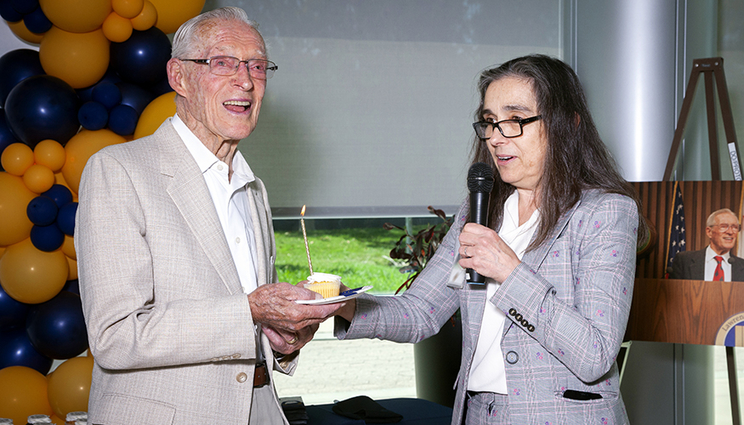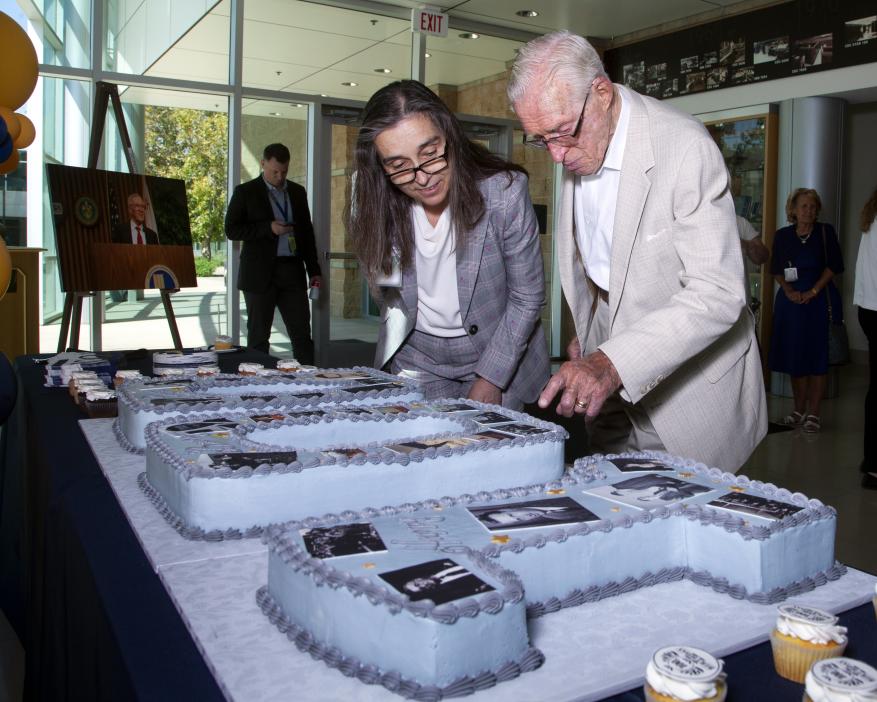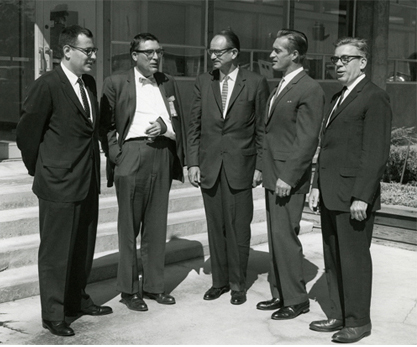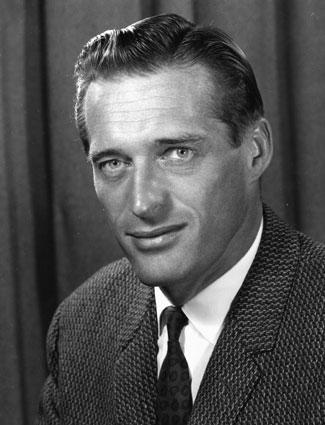Johnny Foster at 100
 (Download Image)
(Download Image)
Following a ceremony for the 2022 John. S. Foster, Jr. Medal, attendees celebrated Johnny Foster’s 100th birthday with cake and brief remarks by Foster and Director Kim Budil.
The Laboratory’s Johnny Foster: nuclear weapon designer and team leader, former Laboratory director, former director of Defense Research and Engineering at the Department of Defense and record-setting ski jumper, turns 100 years old this week. As he does so, Lawrence Livermore National Laboratory celebrates a century of his extraordinary life and accomplishments.
“In my view, Johnny is one of the major forces that has shaped the Laboratory and its culture,” writes George Miller, the Laboratory’s director from 2006 to 2011. “Here are a few examples of what I mean: the willingness to take on major projects in service to the nation, often with significant risk entailed; application of creative science with attendant detailed engineering; and the importance of intense technical questioning and peer reviews. Foster helped the Laboratory to rely heavily on 'premortems,' intense investigations by independent Laboratory groups instituted to review weapons designs before the devices were tested.
“Johnny has a way of asking important and deeply probing questions without ever making you feel threatened,” Miller adds. Foster cultivated the essential role of teams and teamwork where all views are not only welcomed but expected, as well as an atmosphere of openness. “I believe these are both Johnny’s own characteristics but also ones that were honed by his association with Ernest O. Lawrence and other giants of the scientific world,” concludes Miller.
Michael M. May was the Laboratory’s director from 1965 to 1971. “Johnny Foster was my boss for four years in the early ‘60s,” May writes. “He was one of the very best leaders I ever met, at the Laboratory or anywhere else. The Lab has been fortunate in having good leaders, but Johnny left a particular imprint of vigor and dedication.”
Director Kim Budil and Johnny Foster look over his 100th birthday cake, featuring pictures showcasing his life and storied career.
Beginnings in Canada
John S. Foster, Jr., better known to his friends and coworkers as Johnny, was born on Sept. 18, 1922, in New Haven, Connecticut, to John S. Foster and his wife, neé Flora Curtis. At the time, physicist John Sr. was teaching at Yale University. When he was offered a position as an associate professor of physics at McGill University in Montreal, he moved his family back to his native Canada.
Johnny was raised in a suburb of Montreal. He had a natural curiosity about science, tinkered with radios and other electrical devices, was a gifted automotive mechanic and learned to blow glass to make basic scientific instruments. He also was naturally athletic, learning to ski-jump at a hill in a nearby park and participating in gymnastics at McGill University, where he enrolled when he was 18.
Tom Ramos, Livermore physicist, weapon designer and author of a biography of Foster, "Call Me Johnny," notes that Foster was both a scholar and a natural athlete. “He set a North American ski-jumping record, graduated with honors from McGill University that same year and was invited to participate in the 1948 Olympics on Canada’s gymnastics team,” says Ramos. “He was a phenomenal all-around individual.”
As World War II engulfed Europe and the Battle of Britain was raging, Foster, now 21, told his father that he wanted to enlist in the Royal Canadian Air Force. But this never happened. Fate intervened thanks to a friend of John Sr. named Ernest O. Lawrence who had been a student of his when Foster Sr. taught at Yale.
Since earning his Ph.D. in physics at Yale in 1925, Lawrence had been a busy man: founding a laboratory to study atomic physics, the Radiation Laboratory, or Rad Lab, at the University of California, Berkeley; inventing the cyclotron, a type of particle accelerator that sends a beam of protons in a circular path; and developing an interdisciplinary team-based approach to tackling scientific problems. As the European war loomed over the U.S., Lawrence was asked to create a laboratory at MIT to develop effective radar systems for American and British military forces. He recruited his old friend Foster Sr. to move to this new MIT Radiation Laboratory. So, John Sr. moved his family to Cambridge, Massachusetts, for the duration of the war. He also arranged for his son Johnny to get a job at Harvard University’s Radio Research Laboratory.
Reducing pilot casualties in WWII
In Europe, air crews were suffering high casualties during their bombing missions over Germany. After a year as a radio technician for Harvard, Johnny volunteered as a technical adviser to the U.S. Army Air Corps, bringing his deep understanding of radar technology. Reverse engineering a captured German radar, a 21-year-old Foster devised tactics to help B-24 bomber crews outwit the German air defense system. His work as technical adviser led to a substantial decrease in casualties among the bomber groups he worked with.
After the war, Foster returned to McGill University to resume his degree work. He married Barbara Anne Boyd Wickes (known as Bobbie), resumed his gymnastics and ski-jumping activities and graduated with honors in 1948.
Johnny joins E. O. Lawrence at Berkeley
With Johnny back from the war and holding a baccalaureate degree, Foster Sr. asked Lawrence to accept his son at his Radiation Laboratory in Berkeley, and Lawrence eagerly accepted Johnny as a Ph.D. graduate student. Lawrence had seen Johnny perform while the young man was at Harvard and knew all about his abilities. So, in 1949, Foster and his new wife crossed the continent, riding from Montreal to Berkeley on a Vincent HRD motorcycle to begin their new lives.
Foster did his research in Luis Alvarez’s group, where he developed an ion pumped vacuum system proposed by Lawrence to evacuate large volumes of air from the Mass Test Accelerator (MTA), being developed to produce tritium for thermonuclear research. At Alvarez’s suggestion, this work became Foster’s Ph.D. thesis, awarded by the University of California in 1952.
Lawrence took note of Foster’s talents, and that same year asked Foster to join the Rad Lab’s new facility in Livermore, where Foster contributed as a physicist working on the Sherwood Project, an early attempt to harness nuclear fusion for generating energy. Led by physicist Dick Post, another legendary name from Livermore’s history, the project attempted to use magnetic fields to confine a plasma of ions so tightly that the ions would fuse and release energy. After six months, Foster looked around for another assignment; his timing was fortuitous.
The Livermore site had been established to provide the nation with a nuclear weapons laboratory that could concentrate on thermonuclear research. The Los Alamos Laboratory had been the pioneer during the war years, building atomic weapons that were dropped on Hiroshima and Nagasaki and ending World War II. But, with the onset of the Cold War, the needs of the U.S. nuclear stockpile were changing, and significant voices, including Lawrence’s, believed that a second nuclear weapon design laboratory was needed to offer new approaches and alternative designs. That lab was established as the Livermore site of the University of California Radiation Laboratory. It would eventually become Lawrence Livermore National Laboratory.
New horizons in weapon development
At the time of Foster’s request for a new assignment, the new lab had suffered setbacks that threatened its continued existence. In early 1953, tests of Livermore’s first two atomic warheads were failures. With the departure of the head of the Small Atomic Warhead group, which had designed those devices, Lab Director Herbert York asked Foster to take over as leader, renaming Johnny’s new collection of designers the Livermore Hectoton Group.
In July 1953, Foster had to quickly get the group to overcome its past failures and help them figure out how to design and successfully test an original Livermore device, distinct from the weapons Los Alamos had been testing successfully. Foster applied the philosophy, “Take a big enough step so that things get a little radical. Don’t look so far ahead that you really don’t know what you are talking about, but don’t look so close in the future that you are just putting existing pieces together.”
The group had to succeed, especially after a 1954 test of another Livermore-designed device at Bikini Island in the Pacific Proving Ground proved to be a third failure. Word was circulating around Washington D.C. that any more failures would lead the Atomic Energy Commission, the agency charged with overseeing nuclear research, to pull the plug on the new lab.
The 31-year-old Foster and his Hectoton Group produced two designs for much smaller, more compact devices than the larger weapons that Los Alamos had become expert at designing. Foster’s group worked side-by-side with the Megaton Group, led by another young physicist, Harold Brown. Their job was to design a powerful thermonuclear device whose kick came from fusion but nevertheless was small and lightweight enough to be carried by aircraft or missiles. The two groups, led by young upstart physicists with new ideas, were unofficially tasked with getting the young upstart laboratory in Livermore to be recognized as a successful nuclear weapons design enterprise.
In the spring of 1955, Foster’s group successfully tested a device, named Cleo, at the Nevada Test Site. Brown’s group then tested the Linda thermonuclear device, which produced a nuclear yield that was almost exactly as predicted by the group. Together, Foster, Brown and their coworkers had restored faith that the new lab could deliver on its promises. Within the next 24 months, Foster’s Hectoton Group would develop a design that would become the foundation of the modern atomic device.
Michael May wrote that “Johnny can see to the heart of the technical issues that arise in the many areas of science and technology the Lab is involved in. He is innovative and questions the accepted ways of doing things, all in good cheer. He has a gift for inspiring people to work on the problems those people are particularly suited to resolve. And we worked harder than we might have done otherwise, to keep up with him.”
Had he done nothing else, Foster would be remembered forever for these achievements. But the Department of Defense’s strategic approach to countering the threat posed by America’s adversaries required continued development of other types of nuclear devices. Responding to their request to develop nuclear devices small enough for artillery shells, Foster’s Hectoton Group responded in August 1956 with three successful devices that they demonstrated at Enewetok, in the Pacific Proving Grounds. But one of Livermore’s earliest and greatest successes was still to come: a nuclear device for the then-novel idea of missiles launched from submarines.
Livermore in the Cold War
Military strategists in the mid-1950s were becoming increasingly concerned that the nation’s nuclear deterrent was based on missile-launched and bomber-delivered nuclear weapons that could be wiped out in a surprise attack by the Soviet Union. The nuclear deterrent only deterred a nuclear attack if enough weapons survived to launch a retaliatory nuclear strike. A RAND study of U.S. weapons’ survivability suggested that this was unlikely.
In 1956, several nuclear experts, including Foster and fellow Livermore physicist Edward Teller, attended the Nobska Conference in Woods Hole, Massachusetts, called by Adm. Arleigh Burke, chief of Naval Operations. Teller, a towering figure in the Manhattan Project’s development of the first fission bombs during World War II, told everyone at the meeting that a small nuclear warhead could be designed to fit inside a submarine-launched ballistic missile, a claim that was met with disbelief. Teller said the Laboratory could design and test the warhead within five years and Burke took him at his word and awarded Livermore a Navy contract to develop a warhead for the Polaris missile.
As the story goes, Foster went back to Livermore and told Harold Brown what Teller had promised. “He said what?” was Brown’s now-legendary reply.
The Laboratory went to work. As head of B Division, Foster announced in August 1956 the initiation of the Robin program to design a new warhead that was small, rugged and used nuclear fuel efficiently. Although the Robin itself never became a warhead, the design approach developed under Foster’s leadership was such a leap forward that it became the basis of most of the nuclear devices that followed in the stockpile. The design of small nuclear warheads light enough for missiles, to which Foster had contributed so much thinking and leadership, became an essential element of weapon development in the years that followed.
By 1958, when Herb York departed Livermore to establish and become the first director of DoD’s Advanced Research Projects Agency (ARPA), Livermore had tested a small nuclear device that was destined for the warhead for the Navy’s new Polaris missile. In January 1960, the USS George Washington, the first Polaris submarine, began its sea trials. Other Polaris-equipped submarines began roaming the seas over the next two years, furnishing the new President John F. Kennedy, who had taken office in January 1961, with a secure nuclear deterrent with which to counter the Soviet Union. The submarine force arrived in time to provide the United States with a credible nuclear deterrent as it sought to support its western European allies. This deterrent was especially helpful to the President during 1961’s Berlin Crisis, when Soviet Premier Nikita Khruschev threatened to invade West Berlin, but ultimately decided against it.
Teller had become Laboratory director in 1960, but finding the administrative duties not to his liking, stepped down after 18 months. Harold Brown followed, but he departed after only eight months when York asked him to take over ARPA, while York assumed the position of first director for defense research and engineering at DoD. By 1961, the University of California Regents selected Foster to be the new director of Livermore. Six months after the height of the Berlin Crisis, President Kennedy visited the Rad Lab in Berkeley in March 1962 to personally thank the scientists and engineers of Livermore, who by their unprecedented development of the Polaris warhead, helped avert a nuclear war.
It was at this event that Foster showed the President a model of the Polaris warhead and presented him with an idea for an antitheft system to secure tactical nuclear devices from unauthorized use. Foster demonstrated the Permissive Action Link (PAL) technology to Kennedy, who liked the idea and authorized its development. Within a year, PALs began to appear on America’s nuclear devices.
On May 5, 1962, the USS Ethan Allen launched a Polaris missile carrying a Livermore warhead over the Pacific Ocean. It successfully detonated high in the atmosphere, proving to the world the effectiveness and readiness of the submarine leg of America’s nuclear deterrent force.
Foster (second from right) with Lab leaders (from left) Harold Brown, Herb York, Edwin McMillan and Gerry Johnson, celebrating the Lab's 10th anniversary.
Foster joins the Department of Defense
Foster continued to enthusiastically manage the Laboratory for three more years. Under his leadership, the Laboratory continued to provide DoD with innovative national security technologies. The Laboratory also exercised its Plowshare Program to develop special nuclear explosives for peaceful uses and began investigating the use of lasers to achieve inertial confinement fusion. Foster also authorized a Biomedical Division to study the effects of radiation on cell tissue.
Foster left Livermore in 1965 when Secretary of Defense Robert McNamara and new Secretary of the Air Force Harold Brown called him to Washington. Foster served as director of Defense Research and Engineering for three secretaries of defense during the war in Vietnam, overseeing the development of a variety of aircraft, missile and other technologies for the Pentagon, as well as helping prepare for the Strategic Arms Limitation (SALT) talks in the early 1970s. It was Foster who initiated a program to develop and acquire unmanned aerial vehicles for the Armed Forces, leading to today’s Predator drone.
After he left the DoD, Foster served as a member of the President’s Foreign Intelligence Analysis Board, and worked for TRW Inc., helping them advance projects on efficient isotope separation, improving quality control in manufacturing and on energy-efficient cars — helping develop an early design for a hybrid vehicle. Then, in the years following his departure from the private sector, Foster continued to serve on advisory panels and boards for the federal government such as the Defense Science Board, and to advise the Laboratory's senior managers on research directions for nuclear stockpile stewardship.
Writes Michael May: “Another friend of his who worked with him in Washington said that Johnny ‘had no ego,’ a rare quality, particularly in Washington. That is true: in all the many interactions I had with him, it was all about the job to be done, the people to do it and the consequences for the future. It was never about him.
“Johnny believes very strongly in the national defense,” May continued. “He devoted most of his life to it. Because he stuck to technical and programmatic issues and did not stray into politics, he has been trusted by all sides in Washington (though not always agreed with) and has left a strong positive mark there as he has at the Laboratory.”
“Johnny was not alone in creating this Lab ‘culture,’” writes Miller. “E.O. Lawrence, Edward Teller, Herb York, Michael May and others were all key. For me, Johnny does stand out.”
Such is Foster’s influence that the Laboratory named its most important award after him. The John S. Foster, Jr. Medal is administered by Lawrence Livermore National Security, LLC (LLNS) to commemorate his exceptional and inspirational career. The medal is bestowed annually by the Director of Lawrence Livermore National Laboratory on behalf of LLNS to an individual who has demonstrated exceptional leadership in science, technology and engineering or policy formulation in support of U.S. nuclear security. The Laboratory founded the John S. Foster, Jr. Medal in 2015 and Foster was the first recipient of the award named in his honor. He was followed by other giants of national security, including Miller.
Johnny Foster served as LLNL director from 1961-1965, presiding over a time of major growth and expansion for the Lab.
Today, Foster continues to provide advice and mentor scientists at Livermore. Jon Belof, group leader, Material Dynamics and Kinetics, Materials Science Division and leader of the Energetic Materials Center, first met him more than 10 years ago. “Dr. Foster has been a mentor and adviser to me over the past several years. One of the many things that is immediately evident to anyone who meets Johnny (besides his remarkable intellect and insight, at the age of nearly 100) is that he is much more interested in discussing new things — and how we might push the boundaries of the future — than he is in discussing the past. Johnny is always looking to indeed push science and technology capabilities toward the 'radical' side of things and that spirit remains to this day. There are science advancements that exist today that did not exist back in 1952 and it’s crucial that the Laboratory perhaps embrace this 'radical' side because our adversaries certainly are. Johnny has made that crystal clear to us … It’s simultaneously humbling and inspiring to contemplate Johnny’s many critical accomplishments for the country. It is my sincere hope that we can continue to learn from his wisdom in the days to come.”
“We’ve been talking to Johnny several times a year for close to 20 years now,” says Jim Hammer, a physicist in the Weapons and Complex Integration Directorate. “He has been a great mentor and has always asked good questions that stimulate us toward working more effectively. His technical questions and comments are more insightful than from most scientists half his age. He helped steer us in a new direction a few years ago that has proved to be a very good change. He is a person of great determination who has lent us a bit of his own fortitude, and that has made all the difference.”
The Laboratory and its staff wish you happy birthday, Johnny, and thanks for your continuing contributions of your wisdom and insight to the Laboratory.
– Allan Chen
Contact
 Breanna Bishop
Breanna Bishop
[email protected]
(925) 423-9802
Related Links
MedalTags
ScienceCareers
Community Outreach
Featured Articles










